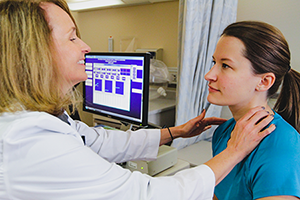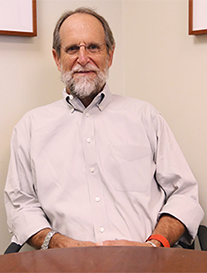News Around NIDDK
Charting a Precision Medicine path to better health
By Amy F. Reiter

Down to our genes, you and I are different people, and may respond better to different treatments – even for the same disease. That's the very basic premise behind a very big project: The Precision Medicine Initiative, announced by President Barack Obama in 2015. Though the term and its accompanying research program are new, the approach has deep roots in much of the research funded and conducted by NIDDK.
Following genetic maps to new treatments
For example, Inflammatory Bowel Diseases (IBD) – Crohn's disease and ulcerative colitis – present differently in different people, and there's no clear way to predict how someone will present. Disease severity, location in the digestive system, and responsiveness to drug treatments all can differ, making these diseases prime candidates for identifying personalized treatments.
In the Division of Digestive Diseases and Nutrition (DDN), the long-running IBD Genetics Consortium maintains a repository of IBD-related biospecimens and has been examining large datasets to discover genes related to IBD and other goals, ideally leading to new drug targets. So far, the consortium has identified about 200 potential chromosomal regions for IBD susceptibility genes. They've also constructed genetic risk scores based on what they've learned that more accurately classify a person's type of IBD.
"Tests which can predict the future disease course and response to treatment for individual patients could greatly reduce the costs and suffering arising from our inefficient methods for making treatment decisions," said DDN's Dr. Robert Karp. "The genetic tests we have for IBD today are relatively crude. As they are improved, we expect that they will become even more accurate guides for choosing treatments for individuals."
Teasing out kidney differences
In the Division of Kidney, Urologic and Hematologic Diseases, the Kidney Precision Medicine Project aims to tailor treatments to people with acute or chronic kidney disease. But first researchers need to better understand what actually happens to kidneys during these diseases. For one part of the project, they'll start by obtaining human kidney biopsies.
"With access to these tissues, we can start to define the different disease pathways that cause kidney disease in different people, and perhaps tease out subgroups," said Dr. Chris Ketchum, deputy director of the Division of Kidney, Urologic and Hematologic Diseases.
Taking a "precision medicine" approach makes sense, Ketchum said, because there are still no effective treatments for acute kidney injury, and only a few that slow the progression of CKD. Though some animal studies have shown promise, similar trials have failed in people.
"One reason for these failures may be individual patient differences," Ketchum said. "We need to better understand the different disease pathways that cause kidney disease in different people so we can start to develop treatments that target these pathways. Then we can do a better job of getting the right person the right treatment."
Awards for the project are anticipated by July 2017.
Sorting genes and making the GRADE
In NIDDK's Division of Diabetes, Endocrinology and Metabolic Diseases, several established projects are focused on accomplishing precision medicine goals. For example, the Accelerated Medicines Partnership Type 2 Diabetes Knowledge Portal enables researchers to sort through more than 100,000 genetic samples to find potential new therapies based on genotypes and other factors.
And the GRADE study – short for Glycemia Reduction Approaches in Diabetes: A Comparative Effectiveness study – is recruiting 5,000 people nationwide to compare four drugs to treat type 2 diabetes to see which is best used as an addition to the first-line drug metformin. Because of the scale, they'll be analyzing racial/ethnic, sex and age differences to help decide which drug is an individual's best choice to achieve optimal blood glucose levels.
"Type 2 diabetes is heterogeneous, both in the course of the disease and how people respond to treatment," said Dr. Drew Bremer, the project scientist for GRADE in NIDDK's Division of Diabetes, Endocrinology and Metabolic Diseases. "Results from GRADE may help determine whether some diabetes therapies work better in people with particular characteristics."
Getting to know: Dr. Phil Smith

Phil Smith, Ph.D., is deputy director of the NIDDK Division of Diabetes, Endocrinology and Metabolic Diseases and co-director of the NIH Office of Obesity Research. In addition to helping develop the division's research priorities, he helps manage basic science consortia and projects in genetics and big data, including the type 2 diabetes efforts of the Accelerated Medicines Partnership (AMP). Smith spoke with Amy F. Reiter about his many roles.
What interested you in biomedical research, specifically genetics and obesity?
I'm the first college graduate in my family. I actually built houses for four years before I went to graduate school. But I'd always done well in academics. During college, I went from thinking about physical designs to biological designs and organisms. I found biology fascinating because you learn things that no one else knows.
What brought you to NIH?
I had two interests, teaching and research. I had a fantastic introduction to research as a postdoc in physiology. Then I went to Uniformed Services University across the street from NIH. But I found I was just so laser-focused on a small area. In 1990, I joined the program staff at NIH, which fit my love of teaching and science and thinking about the big problems. Over 26 years, I've interacted with so many dedicated, committed people, and I'm glad I'm here to help give them resources to do great things.
How has obesity research changed during your NIH tenure?
In the early '90s, we turned from looking at it as a behavioral and motivational problem, to a problem of understanding how the body regulates body weight. Genetics has been key to identifying pathways we never would have imagined are involved in food intake. I was privileged to be part of the team that drove the discovery of these pathways. That helped us understand the processes involved in motivating behavior, as opposed to somebody saying it's simply a matter of human choice. We have so many biological functions we can measure, we're just now at the threshold of a huge area of discovery that will affect how we deal with obesity and potentially diabetes.
You're involved in quite a few "Big Data" projects, including the AMP Type 2 Diabetes Knowledge Portal, which has compiled data from more than 150,000 genetic samples. What do you see as the potential for this approach?
Humans are very different from one another, and we don't yet understand all the differences. With the portal, by combining data of all kinds – behavior, genetics, various exposures – into one place, we'll tease out the key pathways controlling human behavior. We hope to learn not just targets for drug development but also for which people a lifestyle change would be a better treatment than drugs.
We're just now starting to see some really cool progress, and bringing the perspective of scientists that are in pharma and the academics to work together toward common goals has been incredibly rewarding.
What are your interests outside NIH?
I've bought a farm. My dad grew up on a farm, and I've had a garden all my life. I'd love to work with elementary schoolers to grow plants but also provide some of the produce to soup kitchens so they have healthy foods to choose from. That combines my interests in obesity and farming and gardening into one thing – I'll probably be a geeky, scientific farmer. I've learned that as long as you're an active, lifelong learner, you can take on whole new areas – and that's sort of a hallmark of my time here at NIH.

